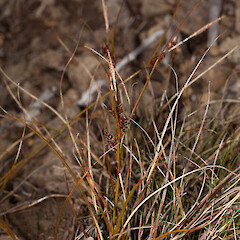Carex traversii
Common name
Travers’s sedge
Synonyms
None
Family
Cyperaceae
Flora category
Vascular – Native
Endemic taxon
Yes
Endemic genus
No
Endemic family
No
Structural class
Sedges
NVS code
The National Vegetation Survey (NVS) Databank is a physical archive and electronic databank containing records of over 94,000 vegetation survey plots - including data from over 19,000 permanent plots. NVS maintains a standard set of species code abbreviations that correspond to standard scientific plant names from the Ngä Tipu o Aotearoa - New Zealand Plants database.
CARTRV
Current conservation status
The conservation status of all known New Zealand vascular plant taxa at the rank of species and below were reassessed in 2017 using the New Zealand Threat Classification System (NZTCS) – more information about this can be found on the NZTCS website. This report includes a statistical summary and brief notes on changes since 2012 and replaces all previous NZTCS lists for vascular plants.
Please note, threat classifications are often suggested by authors when publications fall between NZTCS assessment periods – an interim threat classification status has not been assessed by the NZTCS panel.
- Conservation status of New Zealand indigenous vascular plants, 2017 . 2018. Peter J. de Lange, Jeremy R. Rolfe, John W. Barkla, Shannel P. Courtney, Paul D. Champion, Leon R. Perrie, Sarah M. Beadel, Kerry A. Ford, Ilse Breitwieser, Ines Schönberger, Rowan Hindmarsh-Walls, Peter B. Heenan and Kate Ladley. Department of Conservation. Source: NZTCS and licensed by DOC for reuse under the Creative Commons Attribution 4.0 International licence.
2017 | At Risk – Naturally Uncommon | Qualifiers: RR
Previous conservation statuses
2012 | At Risk – Naturally Uncommon | Qualifiers: RR
2009 | At Risk – Naturally Uncommon
2004 | Range Restricted
Distribution
Endemic. South Island, eastern Nelson, Red Hills and Mt Dun ultramafic are only.
Habitat
An ultramafic endemic confined to open sites within seepages, rubbly ground or damp scree. Sometimes it can be found on boulders or in open, dry ground.
Wetland plant indicator status rating
Information derived from the revised national wetland plant list prepared to assist councils in delineating and monitoring wetlands (Clarkson et al., 2021 Manaaki Whenua – Landcare Research Contract Report LC3975 for Hawke’s Bay Regional Council). The national plant list categorises plants by the extent to which they are found in wetlands and not ‘drylands’. The indicator status ratings are OBL (obligate wetland), FACW (facultative wetland), FAC (facultative), FACU (facultative upland), and UPL (obligate upland). If you have suggestions for the Wetland Indicator Status Rating, please contact: [Enable JavaScript to view protected content]
FACW: Facultative Wetland
Usually is a hydrophyte but occasionally found in uplands (non-wetlands).
Detailed description
Short, densely tufted dark red to purple-red sedge of damp ground and seepages within ultramafic zones. Culms 100–200 × 1 mm, terete, basal sheaths light brown. Leaves usually > culms, rarely ≤ culms, 0.5–1 mm wide, flaccid, lamina plano-convex, margins involute, slightly scabrid towards the filiform usually curled apex. Inflorescence of 3–6 more or less approximate spikes; uppermost male, shortly pedunculate; remaining spikes female, sometimes with 1–2 male flowers near base, 5–10 × 5 mm, sessile with occasional lowermost spike rather distantly pedunculate; subtending bracts leafy, > inflorescence. Glumes slightly < utricles, membranous, light red-brown with a stouter, paler midrib, acuminate, or with a short scabrid awn. Utricles 2.5–3 × 1 mm, subtrigonous to plano-convex, more or less fusiform, dark red-brown, except for the pale beak and the stipe, lateral nerves prominent, remaining nerves faint; beak attenuated, rather narrow, 0.5 mm long, crura acutely bifid, scabrid; stipe hardly contracted, very short. Stigmas 3. Nut 2 mm long, light brown, trigonous.
Similar taxa
Carex traversii is perhaps closest to C. druceana from which it differs by the utricles 2.5–3 mm rather than 2 mm long, these uniformly dark red-brown with a paler beak and stipe, rather than yellowish, with red near the apex and with the beak scarcely evident. Carex traversii is an ultramafic endemic of open rubbley ground. It has been confused with the superficially similar C. uncifolia Cheeseman, but that species prefers poorly drained habitats and has curled leaf apices, and near sessile culms, with densely crowded spikes.
Flowering
September–January
Fruiting
October–June
Life cycle
Nuts surrounded by inflated utricles are dispersed by granivory and wind (Thorsen et al., 2009).
Propagation technique
Easily grown by division of whole plants and from fresh seed. Intolerant of competition and does best in a free draining, magnesium enriched soil. An unusual sedge best cultivated in a pot.
Threats
A naturally uncommon, range restricted endemic, abunbdant within suitable habitat within the ultramafics of the Red Hills and Mt Dun.
Etymology
carex: Latin name for a species of sedge, now applied to the whole group.
traversii: Named after William Thomas Locke Travers (1819-1903) who was an Irish lawyer, magistrate, politician, explorer, naturalist, photographer. He lived in New Zealand from 1849 and was a fellow of the Linnean Society.
Where To Buy
Not commericially available.
Attribution
Fact Sheet prepared by P.J. de Lange (10 August 2006). Description adapted from Moore and Edgar (1970)
References and further reading
Moore LB, Edgar E. 1970. Flora of New Zealand, Volume II. Indigenous Tracheophyta: Monocotyledones except Gramineae. Government Printer, Wellington, NZ. 354 p.
Thorsen MJ, Dickinson KJM, Seddon PJ. 2009. Seed dispersal systems in the New Zealand flora. Perspectives in Plant Ecology, Evolution and Systematics 11: 285–309.
NZPCN Fact Sheet citation
Please cite as: de Lange, P.J. (Year at time of access): Carex traversii Fact Sheet (content continuously updated). New Zealand Plant Conservation Network. https://www.nzpcn.org.nz/flora/species/carex-traversii/ (Date website was queried)











